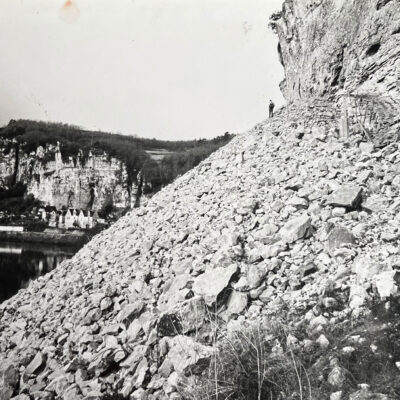La Roque-Gageac
Brief history of the village
The origins of the village go back to Gallo-Roman times. Indeed, the suffix -ac of Gageac, coming from -iacus, meaning “the domain of”, indicates the presence of an ancient Roman villa, certainly that of a man named Gallus.
But the development of the village dates back to the 9th century. At that time, the Vikings sailed up the Dordogne in their longships and set fire to all the villages they stopped in. They went as far as Saint-Cyprien and plundered the monastery. The Abbey of Sarlat-la-Canéda, located only 7km as the crow flies from La Roque-Gageac, the monks then settled in the village and began to fortify it. A double rampart, several fortified gates as well as the troglodytic fort, transformed into a defensive fort, forged La Roque-Gageac’s reputation as an impregnable village.
In addition to being a defensive stronghold, the village became the port for the town of Sarlat. This port activity was to contribute considerably to the economic and demographic development of the village. At the height of its population, the village was home to more than 1500 people.
The cliff
The cliff of La Roque-Gageac was, from Antiquity until the Middle Ages, a natural wall offering almost infallible protection to the inhabitants. However, it has also been a source of fear. The limestone of which it is composed is a friable and above all permeable rock, increasing the risk of landslides. Several landslides have occurred over the years, three of which can be mentioned :
![]() Under the troglodytic fort, on either side of the stairs leading up to it, the bolt marks are the only remains of the fortified tower that guarded the entrance. It was destroyed in a landslide in the 17th century.
Under the troglodytic fort, on either side of the stairs leading up to it, the bolt marks are the only remains of the fortified tower that guarded the entrance. It was destroyed in a landslide in the 17th century.
![]() On 17 January 1957, at around 10am, a huge section of the cliff broke away. The landslide, heard more than 10km away, caused 3 victims. Six houses and a large one were destroyed. A few years later, in the 1960s, another part of the cliff was cleared for safety reasons, as it was also in danger of collapsing. The only remains of the destroyed houses are the marks of the old roofs against the cliff.
On 17 January 1957, at around 10am, a huge section of the cliff broke away. The landslide, heard more than 10km away, caused 3 victims. Six houses and a large one were destroyed. A few years later, in the 1960s, another part of the cliff was cleared for safety reasons, as it was also in danger of collapsing. The only remains of the destroyed houses are the marks of the old roofs against the cliff.
![]() On 9 January 2010, the ceiling of the troglodyte fort broke away. In June, experts discovered that another block just above the fort was also in danger of collapsing. The road through the village was therefore closed for several weeks while safety work was carried out. The site was closed for ten years, while work was carried out to make it safe and allow it to be reopened to the public.
On 9 January 2010, the ceiling of the troglodyte fort broke away. In June, experts discovered that another block just above the fort was also in danger of collapsing. The road through the village was therefore closed for several weeks while safety work was carried out. The site was closed for ten years, while work was carried out to make it safe and allow it to be reopened to the public.
The tourism
 The last gabarre sailed on the Dordogne in the 1920s. This was the end of the golden age of inland waterway transport. The village then turned to an economic policy based on tourism, and this, from the end of the First World War, with a small train that allowed people to come to La Roque-Gageac from Sarlat for only 50 cents! In 1982, La Roque-Gageac became one of the “Most Beautiful Villages of France”, and a few years later the first tour boats appeared, as well as numerous hotels and restaurants in the town and the surrounding plain.
The last gabarre sailed on the Dordogne in the 1920s. This was the end of the golden age of inland waterway transport. The village then turned to an economic policy based on tourism, and this, from the end of the First World War, with a small train that allowed people to come to La Roque-Gageac from Sarlat for only 50 cents! In 1982, La Roque-Gageac became one of the “Most Beautiful Villages of France”, and a few years later the first tour boats appeared, as well as numerous hotels and restaurants in the town and the surrounding plain.
A real treat for the eyes, this small village has become a must-see in the Périgord Noir !










